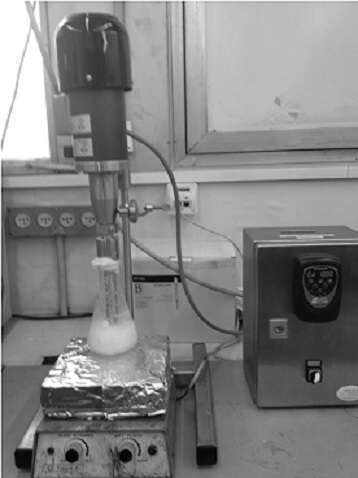Renewable energy sources are being investigated vigorously. The urgency of the research in this field is due to the depletion of fossil fuels. Biofuels, especially bioethanol, have the potential to be substitutes to the current transportation fuels. Any breakthrough in the bioethanol production is beneficial to the socio-economic well being of mankind.
Fermentation is one single reaction that is crucial for bioethanol production. Currently, there is only one pathway available for the conversion of carbohydrates to ethanol, i.e., the biological pathway which is generally time taking. Thus, the focus of the current research is evaluating the ways to enhance the rate of ethanol production from carbohydrates. Glucose is employed as a model carbohydrate and the fermentation reaction is carried out with ultraturrax (Fig. 1.).

Fig.1. Fermentation reaction using ultraturrax
The kinetics of the fermentation reaction was evaluated using 13C NMR spectroscopy [1]. The effect of the stirring speed (rpm, rotations per minute) on the kinetics of fermentation was evaluated. The first order reaction rate constants were observed to be 2.0 x 10-5, 4.0 x 10-5 and 4.2 x 10-5 sec-1 at 5,000, 10,000 and 20,000 rpm respectively. Thus, the mechanical agitation has an accelerating effect on the rate of glucose conversion to ethanol. The optimum value of shaking is 10,000 rpm where the yeast performs the best. Yeast shelf life is also a noteworthy parameter which affects the performance. Long shelf life, nearly six months (k=0.61 x 10-5 sec-1), was found to retard the fermentation rate compared to the fresh yeast (k=2.0 x 10-5 sec-1). The studies point out that, optimal conditions of fermentation, such as pH, presence of additives, and mechanical agitation play an important role in determining the fermentation rate with the stirring speed of the broth being the major factor.
Reference:
1. Indra Neel Pulidindi, Aharon Gedanken, Rekefet Schwarz and Eleonora Sendersky, Energy Fuels, 2012, 26, 2352-2356.

